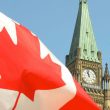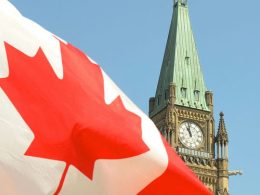by Hubert Marleau, Market Economist, Palos Management
May 9, 2025
Last week, I wrote: “The economic outlook and its residual effect on corporate earnings will be a function of what this Administration will do about trade and taxes over the next 100 days.”
“In this connection, Trump will have to change the narrative on 3 fronts: roll back trade uncertainties of reciprocal tariffs with acceptable deals; invigorate the economy, which could be on the brink of a recession, through new tax incentives; and assure the financial markets that the Fed will remain independent, but under a different ‘modus operandi’. All 3 things are needed to defeat the headwinds to US economic growth head-on and to keep the U.S. Treasury market - the largest and most liquid capital market in the world - liquid to assure the funding of the ‘twin deficits’ without hiccups, and to continue to benefit from the recycling of excess dollars abroad into S&P 500 companies. In this connection, Trump needs to move fast because there are only 2 or 3 months of wiggle room left, otherwise the economy could fall into a self-inflicted recession.”
There is fear that conditions could indeed worsen because tariffs could hurt the supply chain more, business uncertainties could severely hamper business investments, and wholesalers may have to unload huge inventories of imported goods. The level of economic activity fell 0.3% (saar) in Q1, but only because the trade deficit surged. Nonetheless, recessions tend to be caused by sudden shock - the trade war is a classic case in point. This is why Goldman Sachs gives a 45% chance of a recession in the next 12 months, while JPMorgan is even more bearish at 65%. According to Polymarket.com, a trading platform, the odds are 60%.
Contrary to them, I’ve reduced my own subjective odds of a recession from 50% to 35%. I agree that political choices, not economic fundamentals, have led us to a possible recession. The US economy has strong internal underlyings, and is therefore capable of absorbing an-across-the-board average tariff shock of 10%, plus a mid-double-digit one on China, especially if US productivity trends in strategic industries remain advantageous. No less an authority than the Yale Budget Lab estimates the tariffs will reduce GDP between half and one percentage point - not great, but also no recession. As a matter of fact, many trade numbers have been exaggerated. For example, 22% of Chinese-made goods, classified as essential, are exempt from levies, and the volume of container ships departing China has fallen by 50% since mid-April; yet the activity level is still high and has remained consistent with activity seen during much of 2023. Moreover, tariffs are bound to have some domestic import substitution effect.
There is no question that tariffs are not a good idea and can be very disruptive; however, the signals for an upcoming recession are just not there, perhaps because adjustments will take place through the price mechanism and the expectation that a world-wide trade war is avoidable.
Recessions usually do not happen when the yield curve is not inverted (10s minus 2s is 50 bps); when the energy bill as a % of N-GDP is as low as it is presently (2.1%); when the increase is the money supply is accelerating (3.7% to 5.8%); when the swap market is predicting a forthcoming reduction in the policy rate of about 60 bps; and when the dollar becomes competitive, the DXY being down 5.0% y/y. All of that is particularly promising as there is more optimism around China, stabilization in earnings revisions, and few headcount reductions in corporate America. (Incidentally, despite high recession expectations, the Atlanta Fed’s GDPNow model estimate for real GDP in Q2 is 2.2%, while the other NowCast model sees Q2 GDP at +1.4% and Q3 at 1.3%. Both models signal a slowdown, not a contraction.)
So What Went On Last Week ended May 9?
Over the weekend, there were 2 big stories: one was geopolitical and the other was about international trade.
On the geopolitical front, Mark Carney, the Canadian election-victor, said that Canada will implement a trade diversification strategy, engaging with other global trade partners, strengthening relationships with reliable allies who share and uphold similar values that the world respects. He added that he intends to lead the world if the US is not willing to do the job. His pronouncement mimics a 2018 Foreign Affair essay, written by Ivo Daalder, President of the Chicago Council on Global Affairs, and James Lindsay, Chair of the Council on Foreign Affairs, who lamented the fact that Trump was abandoning the international order that Washington had painstakingly created over 70 years. The authors called on Australia, Canada, France, Germany, Italy, Japan, South Korea, the UK and the EU to form the “G-9,” a group dedicated to maintaining global rules “based on collective security, open markets, and democracy.” The countries included would have to learn how to work without the United States - “and, if necessary, around it”-to “supply the leadership that the Trump Administration will not.”
On the economic front, Warren Buffett, the so-called Oracle of Omaha, who represents everything that is good about American capitalism, held his last “Woodstock of Capitalism” with a shot across the bow, broadcasting the Ricardian idea that free trade is good and criticising tariffs in saying: “There’s no question that trade can be an act of war and should not be a weapon”. He added: “We should be looking to trade with the rest of the world. We should do what we do best and they should do what they do best.”
Canadian trade with the United States touches on the argument that Buffett pointed to: crude oil received from Canada that is clearly in America’s interest, given its abundance, and the fact it is received at huge discounts, the sole cause of the US trade deficit with Canada. Incidentally, as the booming U.S. onshore oil and gas industry matures and efficiency levels fall, less active Canadian shale plays stand to benefit, with arguably the best combination of quality inventory and longevity, according to a new white paper from Kimmeridge, a N.Y. energy private equity firm. Think ARC Resources, Tourmaline, and Canadian Natural Resources.
On Monday, the S&P 500 fell 0.6% to 5650, snapping a record 9-day winning streak. It was reasonable for the stock market to take a deep breath, however, as it awaited the Fed’s message on the economy due in a few days.
On Tuesday, the S&P 500 finished lower by 0.8% for a second straight day as there was still no clarity on when new trade deals would be announced. The meeting between President Trump and Prime Minister Carney was rather boring, but the stage for trade negotiations was set to change parts of the USMCA trade pact. There were nonetheless a few clear messages. Trump said the relationship between the 2 countries would be friendlier and the tariff rate would be fair and low while Carney praised Trump on being a transformational president, focused on the American worker, and expressed eagerness to work with the U.S. on defence and security to secure and develop the Arctic. Unfortunately, however, Trump said that Carney had said nothing that could persuade him to drop the US. tariffs on Canadian imports.
Take note that the US international trade deficit soared to $140.5 billion in March, as importers raced to bring in foreign goods, especially pharmaceuticals, and service exports fell $900 million to $95.2 billion in March, led by a large decline in tourism.
On Wednesday, the PBOC eased its monetary stance, lowering the benchmark interest rate by 10 bps to 1.4% and the reserve requirement ratio by 50 bps to 6.2%. Meanwhile, the Fed decided to stay put, keeping its policy rate in the 4.25%-4.50% range because there was no reason to make a change. The preferred inflation rate is running at 2.6%, above the 2.0% target and the unemployment rate is relatively low at 4.2%, reflecting full employment. Thus the monetary stance should be only mildly restive as it is now. However, the Fed is in a difficult spot, as tariff uncertainty roils the outlook for growth and inflation as risks have risen. Powell did broadcast during the press conference indirectly that he would continue to act independently from politics. The session was choppy, but the S&P 500 managed to close higher, rising 0.4% to 5631.
More importantly, Scott Bessent spoke on Fox News, giving an optimistic message that the upcoming negotiations with China will not be about de-coupling but about de-escalating to set a proper tone for trade negotiations.
On Thursday, President Trump announced a “full and comprehensive trade agreement” with the U.K.; the 10% tariff imposed against UK goods will remain in place, but reducing the 25% tariff on steel, cars and aluminum will be reduced to limited amounts. Overall, the deal lowers average British duties on US goods from 5.1% to 1.8% - a US win.
The UK may not be a major exporter to the US; nonetheless the deal is a relief and should be viewed as a promising start toward a world-wide de-escalation of trade tensions, even though it seems to have come out of nowhere and feels somewhat premature. The real deals will be with more meaningful traders, such as India, China, and the EU, where the pressure is on big time. Meanwhile, the EU plans to hit over $100 billion of US exports, including cars and planes, if trade talks fail. Overall, the investors, speculative traders, and Trump pushed the S&P 500 up 0.6% from all angles to 5664.
On Friday, the S&P 500 hardly budged to close at 5660. Thank God, it was TGIF! I have nothing to add.
The Near-Term Stock Market Outlook
The bulls definitely have the upper hand: the US stock market is clearly not pricing in a recession. Yet the rally is confusing, given that the once revered sure-fire index of Leading Economic Indicators (LEIs) has been flashing red for over a year, fashioning a confusing rally. Why?
First, federal funds rate futures show that the market expects several cuts in the policy rate over the next 12 months. Second, headline and core PCED inflation rates are coming closer to the Fed’s 2.0% target. Third, a back-of-the-envelope calculation tells me that productivity gains are holding, despite an official fall of 0.3% in Q1: business capital formation has remained strong especially in productivity-enhancing sectors like business equipment, information processing and data centres (which incidentally soared at an annual rate of 56.2% Q1). Fourth, there’s more optimism on resolving trade issues. Fifth, corporate profits have beaten estimates, while analysts have been stabilising earnings revisions. In this regard, it is now more likely that we will end up with a slowdown than a recession.
In this regard, I’ve altered my own view on the trading range for the S&P 500 to 5500 and 6000 2 weeks ago from a previous forecast of 5300 and 5600. Nevertheless, I think that the best thing investors can do right now is to sit tight and hold their ground because the recession odds might be lower but still elevated, and perhaps lightly add to their preferred positions during dips to lower their cost averages.
Copyright © Palos Management















